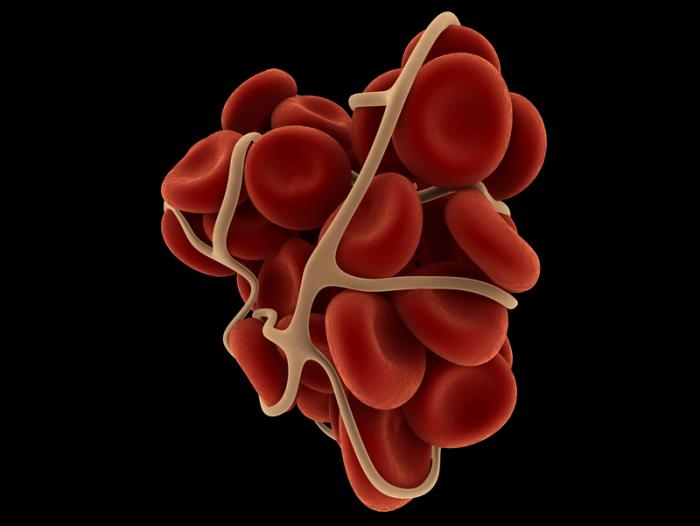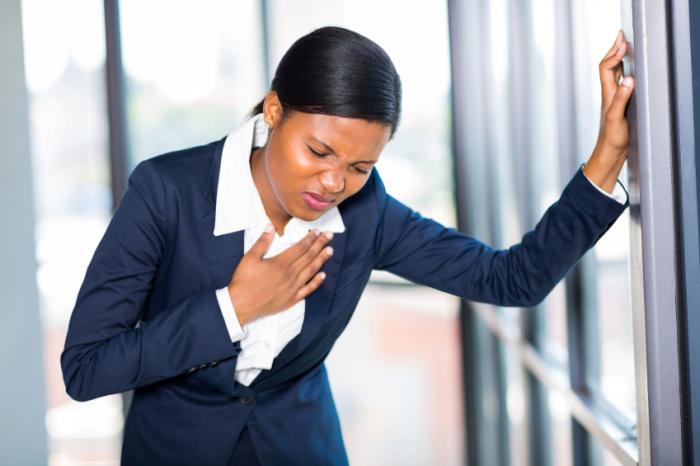Blood clots are the body’s first aid against bleeding. They protect the flow of blood by plugging any leaks that form.
Without blood clotting, smaller vessels that hit a leak inside the body would keep bleeding. If clotting cannot help to seal cuts, the body loses blood from where it needs it – the tissues and organs.
Clotting that rescues damage is a healthy, vital response to danger. But internal clots can also form and dislodge in disease.
This article explains the main clot diseases involving the veins:
- Deep vein thrombosis (DVT) and its symptoms
- Pulmonary embolism (PE) and its symptoms

A blood clot that forms in an artery can cut the supply of blood to major organs.
For blood clots that form directly in arteries, there are also two major events. Broadly, the major artery-forming clots lead to:
- Heart attack – where the heart muscle has its blood supply cut
- Stroke – where part of the brain loses blood supply
This article looks at the clotting in the veins that leads to DVT and PE.
A deep vein thrombosis – usually in a lower leg – is one major cause of pulmonary embolism. This is the DVT going off and lodging in the blood supply for the lungs.
Clots lodging in the lungs are also seen in people without a DVT, and an embolism happens to only some people with a DVT. People can also have both clots separately.
The good news is that research proves that DVT and embolism could become largely preventable. This is why public health scientists have been so interested in researching blood clots.
The Centers for Disease Control and Prevention (CDC) say that 50 percent of all blood clots in the vein events happen in hospital “during or soon after a hospital stay or surgery.” This is one of the risks of needing hospital care and surgery.
Detailed statistics have been published by public health scientists contributing to the CDC. In a paper published in 2010 in the American Journal of Preventive Medicine, it was estimated that blood clots in the veins are “a major public health problem that affects an estimated 300,000 to 600,000 individuals in the United States each year.”
That is equivalent to around 1 or 2 cases in every 100,000 people in the U.S.
Contents of this article:
- What is deep vein thrombosis?
- Symptoms of DVT
- What is pulmonary embolism?
- Symptoms of PE
What is deep vein thrombosis?
Gel-like clumps of congealed blood can form in one of the veins deep in the leg. This is a deep vein thrombosis, or DVT.

Most cases of DVT occur in the calves.
DVTs usually occur in the far limbs – often the lower legs. They are also possible in the arms. DVTs in the leg can be deep in the calf of the lower leg, or in the thigh of the upper leg. Clots can also happen further up, in the pelvis.
Most of the DVTs that happen in the hospital to people at high risk are in smaller veins of the lower leg. These are usually without symptoms and may not be detected.
The CDC confirm that deep vein clots are underdiagnosed but preventable conditions that can be serious.
Some diseases raise the chances of a DVT. Cancer is one example. Most cases of DVT happen in people:
- Whose blood cannot easily get back to the heart because they are unable to move
- Patients with damaged vein linings, including because of a broken bone or major muscle trauma
Arm DVTs are possible, though not common. They also happen due to damage to the lining of a vein. This can be caused by a catheter held in it, or from needle damage when injecting drugs.
It is natural for healthy people to worry about the possibility of a DVT due to other risk factors. Other factors have a part to play in far fewer cases than may be feared.
Clotting is more likely for some people sitting down for long periods on long-haul plane journeys. The contraceptive pill has also shown a link to the risk of DVT.
However, bigger risk factors for DVT include:
- Obesity
- Smoking
- Dehydration
- Previous clots
- Pregnancy
Symptoms of deep vein thrombosis
The following may be signs and symptoms of a deep vein thrombosis. For most DVTs, these are in the calf:
- Swelling
- Pain
- Tenderness
- Redness of the skin
- Warmness of the skin
The pain can feel like a pulled muscle or heavy ache. Whether or not the symptoms turn out to signal a DVT, they are problems that need the attention of a doctor as soon as possible.
Doctors will be able to investigate the full picture, do more tests, and get treatment started. They may look for more detailed signs of DVT, including:
- The location and amount of the swelling, and how this compares with the other limb
- How the tenderness relates to the form of the veins in the leg
- Other factors, including weighing up information to decide the risk of a DVT
Doctors will want to treat or rule out DVT based on other risks. These can include:
- Cancer or recent treatment of it
- Paralysis or partial paralysis
- A leg cast for a fracture
- Recent long-distance travel, including long-haul flights

A pulmonary embolism can cause shortness of breath and pain when breathing deeply.
Doctors look at the overall picture. Another risk they will take greater care over is that DVT is more likely in a patient who has recently been unable to move for more than a few days. Overall, the signs of blood clotting signs, so it is important to rely on doctors for diagnosis and management.
The story of a man getting a DVT after a long-haul flight, which dislodged to the severe problem of a PE some days later is told by the British National Health Service. His description was of “a dull muscular pain, which came and went” for the DVT, and “severe chest pains” later meant a hospital stay for a pulmonary embolism.
The National Blood Clot Alliance have produced a “passport to safety” relating to good tips for helping to prevent DVT.
The authors have included a number of practical measures on the one-page prevention sheet. Ideas include staying hydrated, moving the lower legs, and getting up for a walk.
What is pulmonary embolism?
A pulmonary embolism is a blocked artery in the chest that occurs when a blood clot is pushed along the bloodstream and lodges in the lungs.
DVT and PE are often related, and can sometimes happen together. Doctors will be more alert to the possibility of a PE in anyone with DVT, or who is at high risk of a clot.
Many people have a pulmonary embolism without any DVT, however.
Symptoms of pulmonary embolism
A clot in the lungs produces serious symptoms that need urgent medical attention.
PE may be signaled by:
- Shortness of breath – finding it difficult to get enough breath for no obvious reason
- Pain when breathing deeply
Other symptoms of PE can include:
- Fast breathing and a fast heart rate
- Blood when coughing
Any of the above symptoms need urgent medical attention, whether the problem could be pulmonary embolism or another potentially serious condition.
Other serious symptoms that can go with PE include:
- Anxiety or dread
- Collapsing with a light head or fainting
- Sweating
People should always seek medical help when feeling unwell and concerned.
